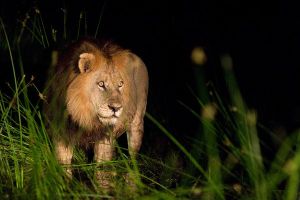Biggest Conservation Area Created in Africa

National Geographic (Christine Dell’Amore)
A male African lion wanders Botswana’s Okavango Delta, part of a new international conservation area that will be the world’s largest, organizers announced earlier this month.
Spanning an area of Africa almost the size of Italy, the Kavango Zambezi Transfrontier Conservation Area, or KAZA, will encompass 36 national parks, game reserves, wildlife-management areas, and tourism areas, according to WWF, a conservation organization offering both technical and financial support to the initiative.
In 2011 presidents of five African nations—Angola, Botswana, Namibia, Zambia, and Zimbabwe—signed a treaty establishing the huge protected region, which has been in the works for several years.
“It’s quite unique, in that you have five countries coming together with a shared vision, and it’s a vision based on conservation,” said Lisa Steel, director of WWF’s Namibia Program.
“The intent is to make it a leading conservation area and tourist destination in the region … where communities are the main beneficiaries.”

Lionesses feed at night in Botswana's Okavango Delta. Photograph by Beverly Joubert, National Geographic
Conservationist Brian John Huntley, a professor at the University of Cape Town in South Africa, has worked in the region for four decades. He said KAZA has “noble intentions.”
However, such transfrontier conservation areas have previously “been launched with great fanfare [and] political posturing at the level of presidents and prime ministers, and even though they’ve attracted a considerable amount of donor funding, very few—if any—have actually succeeded in their goals, simply because of lack of capacity in various countries,” Huntley said.
“Like many other grandiose schemes foisted upon Africa, KAZA is an invention of the imagination of a few conservationists who believe that big is beautiful, have little experience of institutional realities or responsibilities, but enjoy the fun of grand design.”
With the exception of Angola, the KAZA countries are already well-known for their successful ecotourism and wildlife-viewing industries.
In terms of tourism, KAZA “promises a great deal, and could bring enhanced economic benefit to an area that already does well for ecotourism, and could do a lot better,” said Stuart Pimm, a conservation ecologist at Duke University who is also a contributor to the National Geographic News Watch blog.
KAZA houses “one of the most spectacular areas of wildlife in Africa,” he added.

Photograph by Chris Johns, National Geographic
Thousands of species will be given new freedom to roam throughout KAZA, including cheetahs, rhinos, elephants, wild dogs, lions, buffalo, hippos, and leopards.
Despite the challenges facing KAZA, “I’m still of the belief that any conservation agenda should be encouraged,” Huntley said, “but the expectations should be kept extremely realistic.”



